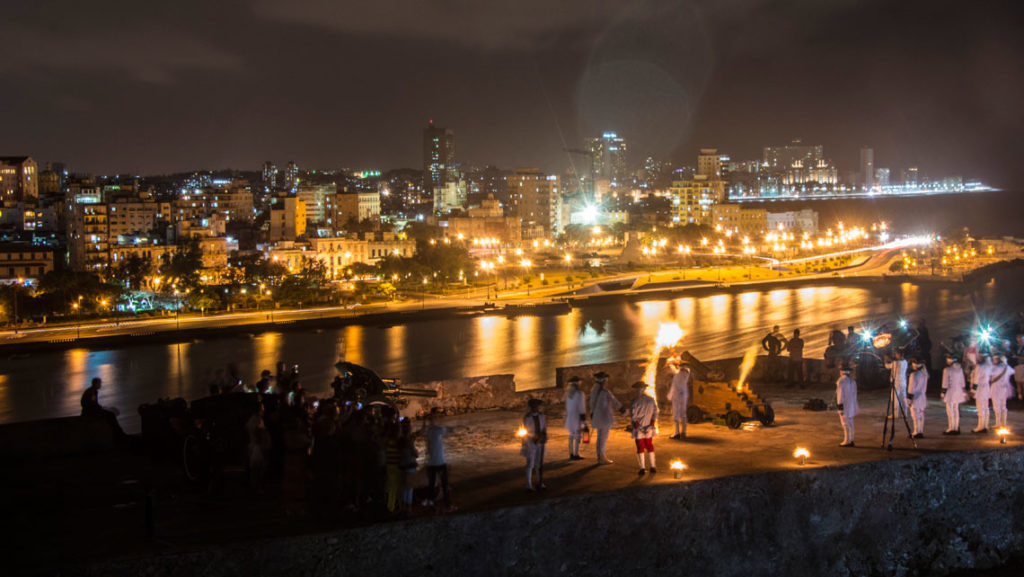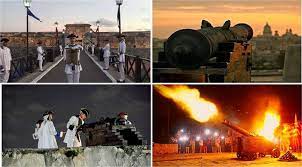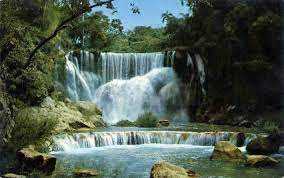LA HABANA, CUBA Y SU PUNTUAL CAÑONAZO DE LAS NUEVE DE LA NOCHE. PHOTOS/VIDEOS
La Fortaleza de la Cabaña está cerca de La Habana Vieja, al otro lado de la Bahía. Cada noche a las 9 pm en punto, se realiza una tradición colonial, se realiza lo que se llama El Cañonazo de las Nueve, una ceremonia que data del siglo XVIII y consiste en un disparo de cañón, realizado infaliblemente a las 21:00 hora local (9:00 PM) desde la Fortaleza San Carlos de la Cabaña, la cual junto al Castillo de los Tres Reyes del Morro domina la entrada a la bahía de la ciudad y al principal puerto de la Isla.
Con puntualidad más allá de la exactitud, todos los días del año, ya sean de fiesta o de duelo, a las nueve de la noche, ni un minuto más ni un minuto menos, desde la Fortaleza de San Carlos de la Cabaña se dispara un cañonazo, llamando a revisar los relojes.
Convertida en nuestros días en un lucrativo espectáculo turistico, en sus orígenes era la fórmula oficial de aviso a pobladores y visitantes de la capital cubana, para que a partir de ese instante permanecieran tras las gruesas murallas que a lo largo de decenas de kilómetros rodeaban la villa para resguardarla contra ataques de corsarios y piratas.
En cualquier confín del mundo que se encuentre un habanero, jamás podrá olvidar una antiquísima costumbre de la tierra que lo vio nacer.
 VIDEOS- LA HABANA, el Cañonazo de las Nueve (Ceremonia)…
VIDEOS- LA HABANA, el Cañonazo de las Nueve (Ceremonia)…
RECUERDOS DEL “CAÑONAZO DE LAS NUEVE” EN LA HABANA
Hubo una época en que uno podía seguir el ritmo de la vida y poner el reloj en hora gracias a avisos lejanos. “Acuéstate que hace rato que sonó el cañonazo…” eran frases familiares entonces, como familiares eran aquellos sonidos.
En ese entonces, por los años 50s no se necesitaba ver la hora pues el pito de las siete advertía que se imponía salir de la cama y empezar a prepararse para el colegio. Uno podía poner los frijoles en remojo, empezar a desalar el tasajo, tomarse las pastillas que recetó el médico y, en definitiva, regir su horario con aquellos anuncios, aunque La Habana vivió durante unos dos años y medio sin su tradicional disparo y, al menos en una ocasión el cañonazo sonó fuera de hora. Parecerá increíble, pero fue así: el 18 de septiembre de 1902, el disparo no se hizo a las nueve, sino a las 9:30, y nunca se explicó el por qué.
Se dice que La Habana sin su cañonazo es como si le faltara el Malecón, porque el cañonazo de las nueve es tan habanero como el Morro, La Giraldilla y La Fuente de la India. Mas entre el 24 de junio de 1942 y el 1 de diciembre de 1945 no hubo cañonazo que valiera en la ciudad. Cuba había entrado en la Segunda Guerra Mundial y el Estado Mayor del Ejército prohibía el disparo nocturno a fin de ahorrar pólvora y no ofrecer nuestra posición al enemigo.
Allá por los años 50 un empresario radicado en Puerto Rico recibió en su establecimiento la visita de un sujeto que dijo ser habanero y pedía empleo. El dueño del negocio, cubano, para constatar si el visitante decía la verdad o no, le hizo dos preguntas clave: ¿A qué hora mataron a Lola? ¿A qué hora suena el cañonazo?
A la primera interrogante, el supuesto habanero respondió que no se encontraba en la ciudad el día del asesinato de Lola, y con respecto al cañonazo, dijo que La Habana era una urbe tranquila y pacífica, y demostró así que debió haber nacido en otra parte y que de la capital cubana no sabía absolutamente nada pues, aunque no pueda ya precisar con certeza quién fue Lola, nadie en Cuba desconoce que la mataron a las tres de la tarde y mucho menos ignora la hora del cañonazo.
EL CAÑONAZO DURANTE LA CUBA COLONIAL
Durante la Colonia, el cañonazo sirvió para anunciar que se abrían y se cerraban las puertas de las murallas que, decía el historiador Emilio Roig, “formando un enorme cinturón de piedra, rodeaban y defendían, como inexpugnables fortalezas de su época, la primitiva, modesta, sencilla, patriarcal y pequeña ciudad de San Cristóbal de La Habana”.
Porque entonces no era un solo cañonazo, sino dos. Y coexistían dos ciudades, que eran una sola, la de intramuros y la de extramuros, divididas por aquel paredón. A las 4:30 de la mañana, al toque de diana, el cañonazo indicaba que debían alzarse los rastrillos, tenderse los puentes levadizos y abrirse las puertas de las murallas para permitir el tráfico entre una parte y otra. Y el de las ocho de la noche, al toque de retreta, disponía que se hiciera lo contrario. Caían los rastrillos, se elevaban los puentes y se cerraban las puertas y nadie entonces podía entrar en la ciudad amurallada. Ni salir.
El disparo se hacía desde el buque de guerra que servía de Capitanía en el Apostadero; luego, empezó a hacerse desde la fortaleza de la Cabaña, y con el tiempo, cuando el toque de retreta dio paso al toque de silencio, desapareció el cañonazo de las 4:30 y el de las ocho empezó a escucharse a las nueve de la noche, costumbre que se mantuvo luego de la desaparición de las murallas con el único objetivo de anunciar pueblerinamente la hora y llega hasta hoy.
Hoy día, desde la fortaleza de San Carlos de la Cabaña se efectúa la acostumbrada detonación por un pelotón de cadetes de artillería ataviados a la usanza colonial y con una pieza del siglo XVIII, espectáculo diseñado para el turismo nacional e internacional que con interes puede contemplarse.
HAVANA, CUBA, AND ITS TIMELY GUN AT NINE AT NIGHT. PHOTOS / VIDEOS
La Cabaña Fortress is near Old Havana, on the other side of the Bay. Every night at 9 pm sharp, a colonial tradition is carried out, what is called El Cañonazo de las Nueve is performed, a ceremony that dates back to the 18th century and consists of a cannon shot, infallibly performed at 9:00 p.m. local (9:00 PM) from the San Carlos de la Cabaña Fortress, which next to the Castillo de Los Tres Reyes del Morro dominates the entrance to the city’s bay and the main port of the Island.
With punctuality beyond accuracy, every day of the year, whether partying or mourning, at nine o’clock at night, not a minute more, not a minute less, from the San Carlos de la Cabaña Fortress a cannon shot, calling to check the clocks.
Converted in our days into a lucrative tourist spectacle, in its origins, it was the official formula of warning to residents and visitors of the Cuban capital so that from that moment they would remain behind the thick walls that for tens of kilometers surrounded the city. villa to protect it against attacks by corsairs and pirates.
In any corner of the world that habanero is, he will never be able to forget an ancient custom of the land where he was born.
 VIDEOS- LA HABANA, the Nine O’Clock Gun Shot (Ceremony)…
VIDEOS- LA HABANA, the Nine O’Clock Gun Shot (Ceremony)…
MEMORIES OF THE “CAÑONAZO DE LAS NINE” IN HAVANA, CUBA
There was a time when one could keep up with the rhythm of life and set the clock thanks to distant warnings. “Go to bed, the cannon sounded a long time ago …” were familiar phrases then, as familiar were those sounds.
At that time, in the 1950s, it was not necessary to see the time because the seven o’clock whistle warned that it was necessary to get out of bed and start preparing for school. One could soak the beans, begin to desalt the jerky, take the pills that the doctor prescribed and, ultimately, govern their schedule with those advertisements, although Havana lived for about two and a half years without its traditional shot and, at the same time, except on one occasion the cannon shot sounded out of time. It will seem incredible, but it was like this: on September 18, 1902, the shot was not fired at nine, but at 9:30, and why was never explained.
It is said that Havana without its cannon shot is as if it lacked the Malecón because the nine o’clock cannon is just as Habanero as El Morro, La Giraldilla, and La Fuente de la India. But between June 24, 1942, and December 1, 1945, there was no cannon shot that was worth in the city. Cuba had entered the Second World War and the Army General Staff prohibited night shooting in order to save gunpowder and not offer our position to the enemy.
Back in the 1950s, a businessman living in Puerto Rico received a visit from a man who said he was from Havana and asked for a job. The owner of the business, Cuban, to verify if the visitor was telling the truth or not, asked two key questions: What time was Lola killed? What time does the cannon fire?
To the first question, the alleged Havanan replied that he was not in the city on the day of Lola’s murder, and regarding the cannon shot, he said that Havana was a calm and peaceful city, and thus demonstrated that he must have been born elsewhere and that she knew absolutely nothing about the Cuban capital because, although she can no longer specify who Lola was, no one in Cuba is unaware that she was killed at three in the afternoon, much less ignorant of the time of the cannon shot.
THE CANYONAZO DURING COLONIAL CUBA
During the Colony, the cannon shot served to announce that the gates of the walls were opening and closing, which, according to the historian Emilio Roig, “forming an enormous stone belt, surrounded and defended, like impregnable fortresses of their time, the primitive, modest, simple, patriarchal and small city of San Cristóbal de La Habana ”.
Because then it was not a single cannon shot, but two. And two cities coexisted, which were only one, the intramural and the extramural, divided by that wall. At 4:30 in the morning, at the touch of the bullseye, the cannon shot indicated that the rakes should be raised, the drawbridges should be raised and the gates of the walls open to allow traffic between one part and another. And the eight o’clock at night, at the sound of the retreat, ordered the opposite to be done. The rakes fell, the bridges were raised and the gates were closed and no one could then enter the walled city. Neither goes out.
The shot was fired from the warship that served as Captaincy in the Post Office; Later, it began to be done from the fortress of the Cabaña, and over time, when the retreat gave way to the silence, the 4:30 cannon shot disappeared and the eight o’clock began to be heard at nine o’clock. night, a custom that was maintained after the disappearance of the walls with the sole objective of announcing the time in the village and it continues until today.
Today, from the fortress of San Carlos de la Cabaña the usual detonation is carried out by a platoon of artillery cadets dressed in colonial style and with an 18th-century piece, a show designed for national and international tourism that can be viewed with interest.
Agencies/ Wiki/ EcuRed/ Ciro Bianchi/ Internet Photos/ YouTube/ Arnoldo Varona/ www.TheCubanHistory.com
THE CUBAN HISTORY, HOLLYWOOD.










